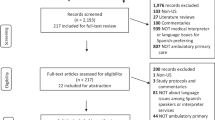Abstract
OBJECTIVE: To describe the utilization of various methods of language interpretation by Spanish-speaking patients in an academic medical clinic and to determine patients’ and physicians’ satisfaction with these methods.
METHODS: Survey administered to medical residents and Spanish-speaking patients asking about their experience and satisfaction with various methods of language interpretation.
MAIN RESULTS: Both patients and residents had the highest level of satisfaction for professional interpreters (92.4% vs 96.1% reporting somewhat or very satisfactory, p=.17). In contrast, patients were significantly more satisfied than residents with using family members and friends (85.1% vs 60.8%, p<.01). Physicians and patients agreed that accuracy, accessibility, and respect for confidentiality were highly important characteristics of interpreters (>90% of both groups reporting somewhat or very important). However, patients were more concerned than residents about the ability of the interpreter to assist them after the physician visit (94% vs 45.1%, p<0.01).
CONCLUSIONS: Using family members and friends as interpreters for Spanish-speaking patients should be more seriously considered; however, in order to optimize patient satisfaction, differences between patients and providers should be taken into account when using interpretation in medical settings.
Similar content being viewed by others
References
Statistical Abstract of the United States 1997. 117 ed. Washington, DC: US Bureau of the Census; 1997.
Woloshin S, Schwartz LM, Katz SJ, Welch HG. Is language a barrier to the use of preventive services? J Gen Intern Med. 1997;12(8):472–7.
Manson A. Language concordance as a determinant of patient compliance and emergency room use in patients with asthma. Med Care. 1988;26(12):1119–28.
Baker DW, Parker RM, Williams MV, Coates WC, Pitkin K. Use and effectiveness of interpreters in an emergency department. JAMA. 1996;275(10):783–8.
Delivering Preventive Health Care to Hispanics: A Manual to Providers. Washington, DC: The National Coalition of Hispanic Health and Human Services Organizations; 1990.
Hayes RP, Baker DW. Methodological problems in comparing English-speaking and Spanish-speaking patient’s satisfaction with interpersonal aspects of care. Med Care. 1998;36(2):230–6.
Carrasquillo O, Orav EJ, Brennan TA, Burstin HR. Impact of language barriers on patient satisfaction in an emergency department. J Gen Intern Med. 1999;14:82–7.
Author information
Authors and Affiliations
Additional information
This work was supported by a research grant from the Department of Medicine of Rhode Island Hospital, where Dr. Kuo was a Fellow in General Internal Medicine, and the Health Research Services Administration.
Rights and permissions
About this article
Cite this article
Kuo, D., Fagan, M.J. Satisfaction with methods of spanish interpretation in an ambulatory care clinic. J GEN INTERN MED 14, 547–550 (1999). https://doi.org/10.1046/j.1525-1497.1999.07258.x
Issue Date:
DOI: https://doi.org/10.1046/j.1525-1497.1999.07258.x




